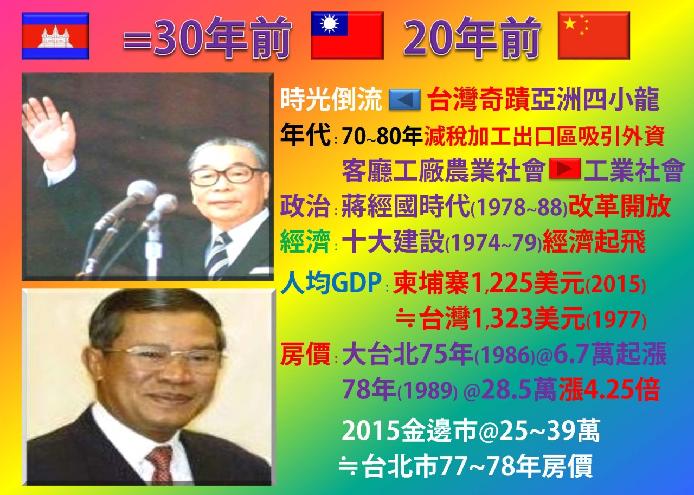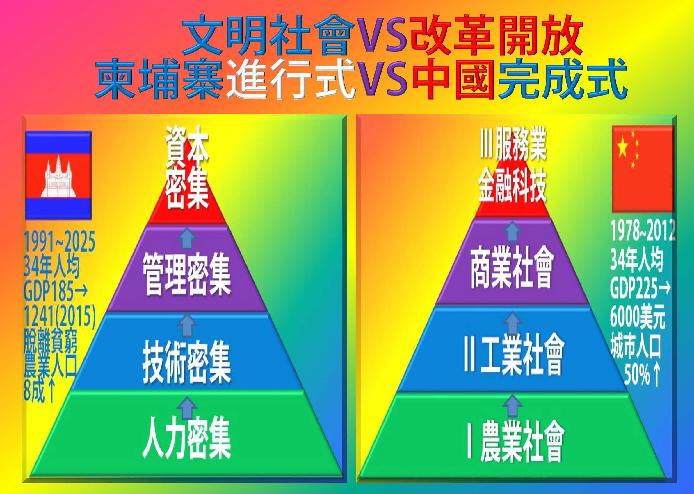
Cambodia's Reform and Opening-up Copy the Experience of China and Taiwan
China's Reform and Opening Up VS Cambodia's Reform and Opening Up
China is not a communist country 30 years ago VS Cambodia is not 40 years ago Khmer Rouge
1. China's Reform and Opening-up Completion Ceremony
In 1978, China began to implement the policy of "reform internally and open externally". In the early stage of reform and opening up, the introduction of foreign capital mainly came from foreign government loans. Provide tax-free preferential period, cooperate to set up factories, learn and absorb foreign enterprise capital management and marketing methods. Create a large number of employment opportunities, accelerate the development of foreign trade, and improve the international competitiveness of the economy. Foreign investment promotes the sustained, rapid and healthy development of the national economy, effectively makes up for the shortage of domestic construction funds, promotes technological progress and management level improvement, and promotes the adjustment and upgrading of industrial structure. Most of them are labor-intensive processing projects and tertiary industry projects such as hotels and service facilities. By the mid-to-late 1990s, the focus of foreign investment had shifted from labor-intensive industries such as textiles and light industry to capital- and technology-intensive industries such as electronic communications, automobile manufacturing, and chemical industries.
In 1984, 14 cities such as Guangzhou and Shanghai were opened up as "coastal open cities", and the Bohai Rim, Yangtze River, Pearl River, and Xiamen-Zhangzhou-Spring Delta regions were designated as economic open zones. Amazing progress has been made in a short period of time. Shenzhen has grown from a village in Niwan to a prosperous city comparable to Hong Kong across the river from Shenzhen. The remaining three places also became a huge bright spot of China's economy in the early 1980s. Open 14 cities to achieve an average annual economic growth of more than 10%. In 1988, after realizing the huge economic benefits brought by foreign trade, the Chinese government established Hainan as a separate province and opened the whole province to the outside world, becoming China's largest open area. At the same time, the locations that are open to the outside world are also developing inland along with the coast. Now all provinces and cities have the right to plan land and set up open areas with the approval of the State Council. This has become a major factor in stimulating China's economic take-off. In 1992, Deng Xiaoping published the "Southern Tour Talk": "If you don't adhere to socialism, don't reform and open up, don't develop the economy, don't improve people's lives, you can only die. Reform and opening up will promote economic development and people's lives will be improved. Therefore, the army , state power, must uphold this road, this system, and these policies.”
From 1978, when the reform and opening up began, to 2012, after 30 years, China's national power has been greatly enhanced, and its international status and military strength have been significantly improved. In 2010, China's GDP surpassed that of Japan and became the world's second largest economy after the United States. The per capita GDP increased from US$225 to US$6,000. In 2014, China's foreign exchange reserves were approximately US$4 trillion. The output of many economic products in China ranks first in the world. In 2007, the total GDP of China surpassed that of Germany; in 2010, the total GDP of China surpassed that of Japan and became the second largest economy in the world. million), becoming the first province in mainland China whose total GDP exceeds that of Taiwan. After 2012, the GDP of Jiangsu, Shandong, and Zhejiang has also surpassed that of Taiwan, and Guangdong has more than doubled. Beijing, Shanghai, beyond Hong Kong. The proportion of China's urban population has risen from 20% to over 50%. (Source: Wikipedia reform and opening up)
2. Reform and opening up in Cambodia
China started reform and opening up in 1978 and completed reform and opening up in 30 years. After 13 years behind China, Cambodia began to learn from China's experience and carry out reform and opening up in 1991.
Cambodia's reform and opening up copy Taiwan and China's experience Cambodia = 30 years ago Taiwan 20 years ago China
1. Taiwan's experience in the 1970s and 1980s (1980s and 1990s). Politics: Chiang Ching-kuo era (1978~88). From 27 to 37 years.
Construction: Ten major construction projects (1974~1979), development of heavy industry and chemical industry, large-scale public investment, basic projects such as transportation and electric power, steel, petrochemicals, shipbuilding, and cross-roads. Income continued to increase. Major economic construction, joining the four Asian tigers, creating a Taiwan miracle, and becoming a model for developing countries.
Economy: Free and open economic and trade policies, lower tariffs, relax imports, reduce and exempt taxes, and attract foreign investment. Kaohsiung Nanzi and Tanzi Processing and Export Zones were established, foreign capital increased substantially, the economy took off, and Taiwan’s money was flooded. From a primary industry agricultural society to a secondary industry industrial society.
Per capita GDP: Taiwan's per capita GDP was US$1,150 in 1965 (1976), and US$1,323 in 1966 (1977). It is equivalent to Cambodia's per capita GDP of US$1,145 in 2014 and US$1,225 in 2015. 38 years apart.
Housing prices: The average price of Greater Taipei began to skyrocket in 1975 (1986) @ 67,000, and in 1978 (1989) @ 285,000, an increase of 425%. In 1978 (1989), Taiwan's economy took off, and the stock market exceeded 10,000 points for the first time, and the average price in Taipei City @285,000. In 2015, the housing price in Phnom Penh, Cambodia was about NT$250,000~390,000, which was equivalent to the housing price in Taipei City in 1977~78 (1988~1989). A difference of 27 years.
2. History will repeat itself, copy Taiwan's experience, real estate life, you can do it again
According to 1. China's reform and opening up 2. Taiwan's economic miracle experience 3. Cambodia's 10-year economic development "Cambodia 2030 Strategy" 4. Views of Cambodian real estate industry: as long as political stability and economic growth, the price of real estate in Phnom Penh will increase in the next 5 to 10 years It will maintain a growth rate of 10~15% every year. Future development vision: In 2025, "labor-intensive industries" will shift to "technology-intensive industries" and then be upgraded to "technical industries". Within 10 years to 2025, as long as political stability and economic growth will drive real estate in the locomotive industry. Phnom Penh house price: 2015 @ ping 300,000, 2020 will reach @ ping 48~600,000. |




 .......热点省份代理人 詹经理 Rock Chan
.......热点省份代理人 詹经理 Rock Chan